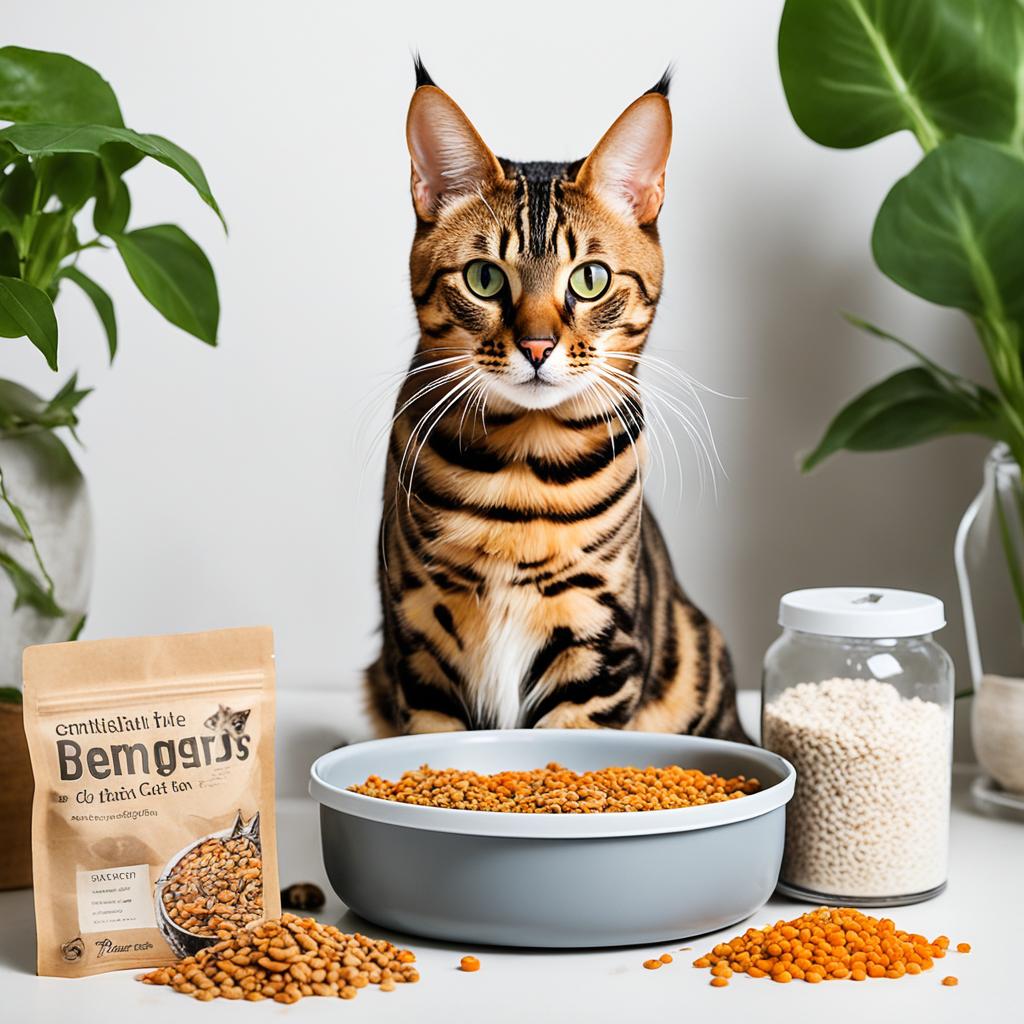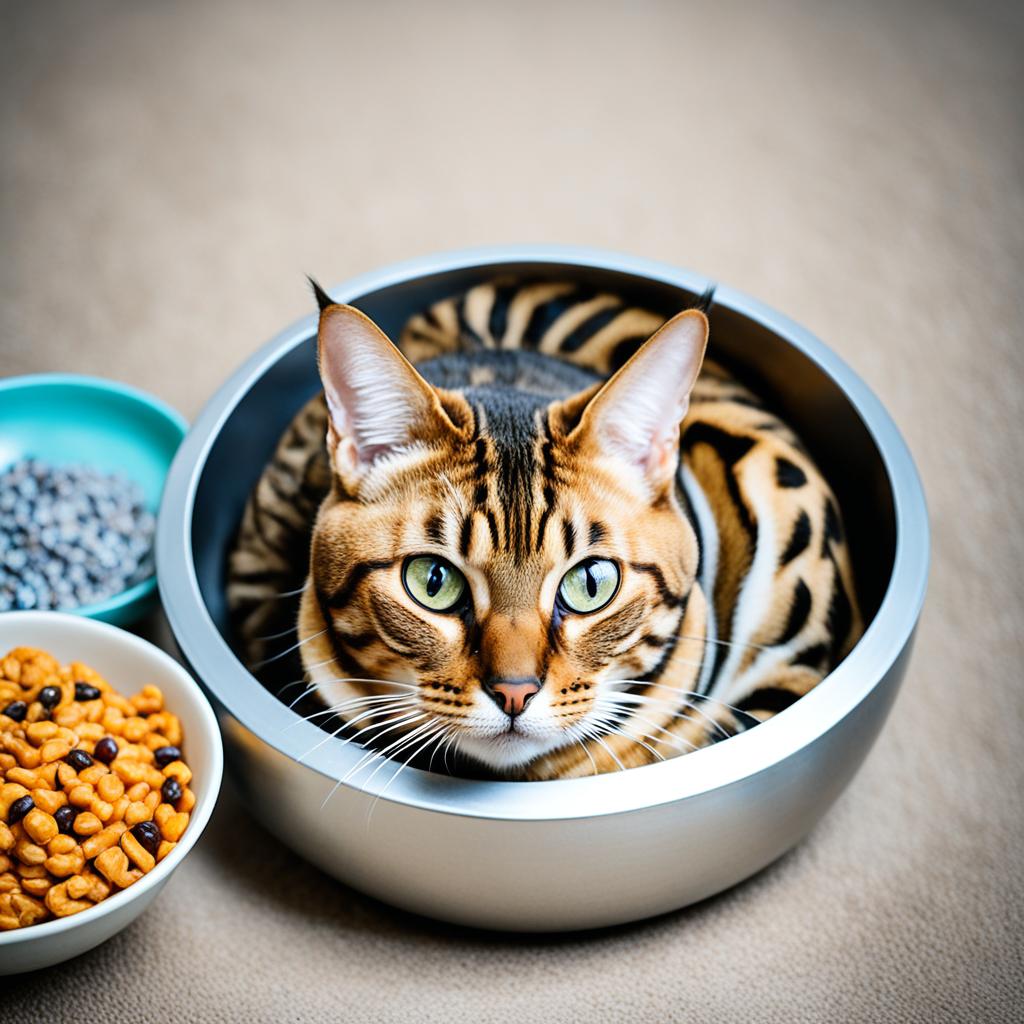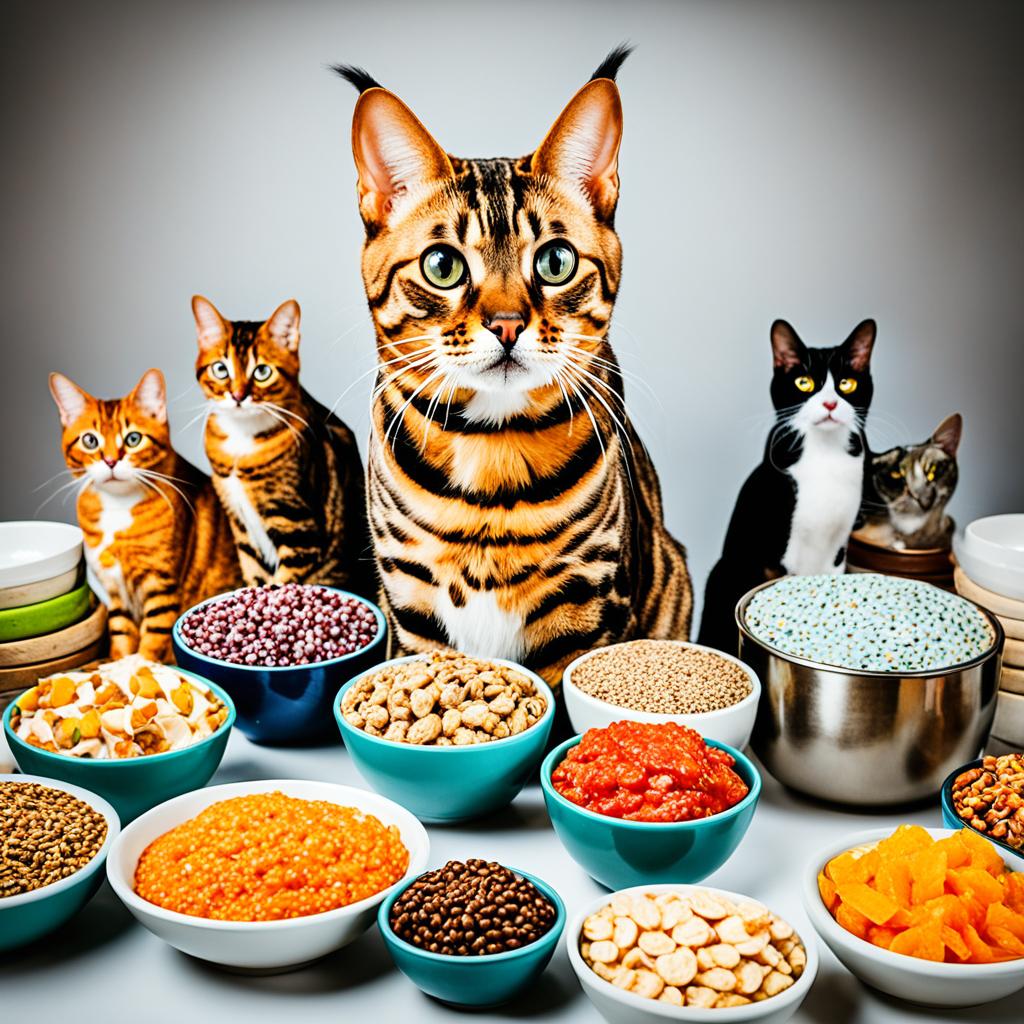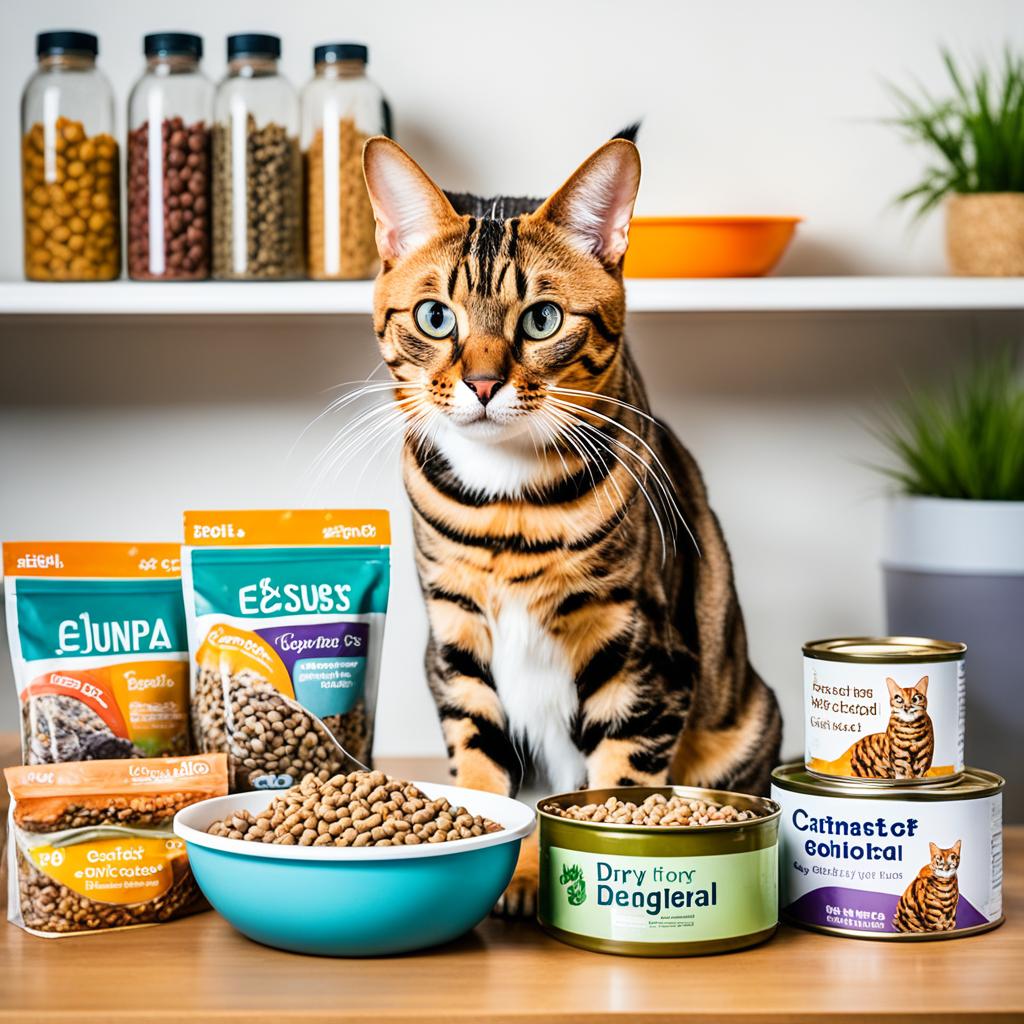Ever found yourself wondering why your once-eager Bengal cat now seems uninterested in meals? If your Bengal seems to be skipping on meals or has suddenly lost their appetite, you’re not alone. Many Bengal owners face a puzzling situation where their feline friends refuse food, even treats they once loved like cream. This puzzle can be harder to solve for Bengals raised on dry food who show a strong dislike for wet food. Moreover, it’s tricky to keep them properly hydrated if they won’t eat the moist food you try to give them.
To tackle a Bengal’s eating problem, looking into what they ate before, what they need now, plus adding new food options is essential. Even cats who used to eat anything might start being picky. This change suggests it’s time to pay closer attention to their eating.
Key Takeaways
- Bengal cats may refuse food due to past dietary habits.
- Ensuring hydration is crucial, especially if they avoid wet food.
- Picky eating can hint at deeper issues needing careful consideration.
- Understanding previous food experiences can guide current diet choices.
- Introducing new foods gradually may reignite their interest in eating.
Understanding Your Bengal Cat’s Dietary Needs

Getting what your Bengal cat eats right is crucial for its health and joy. Bengals need a diet that reflects their wild ancestors. Today, we try to meet these needs with the cat food available.
The Ancestral Diet
Bengal cats’ roots go back to wildcats that lived in the Fertile Crescent. Their diet included mainly hunting for food. This means their diet was rich in protein and nutrients they needed to survive.
Now, we feed them high protein cat food to mimic that ancient diet. This type of food is more like what their wild ancestors would have eaten.
Modern-Day Meal Options
Today, meeting a Bengal cat’s dietary needs is different. It’s not about hunting anymore. It’s about picking the right cat food. The best cat food has lots of protein, good fats, vitamins, and minerals.
These foods are made to keep a Bengal cat’s muscles strong and energy up. It also keeps them healthy all-around.
When picking food, go for options that mimic their wild ancestors’ diet. The food should be high in protein and not have any useless extras. This way, your Bengal cat gets food that helps them be their best.
Possible Health Issues Affecting Appetite
If your Bengal cat starts ignoring its meals, this warns you to check for health problems. Taking action early is key to their health. Helping your cat eat well again improves its overall life.
Common Medical Conditions
Bengal cats might have simple issues like dental problems or more complex ones like stomach troubles. Tooth pain makes eating hard, so they eat less. And stomach problems can cause them pain and reduce their appetite.
When to Visit the Vet
Feeding problems in Bengal cats demand a vet’s attention. Early vet care stops small issues from becoming big. Be on the watch for other signs like being sluggish or losing weight. These mean it’s time to see the vet.
Environmental Factors that Could Contribute

Bengal cats are picky eaters, picking up on the vibes around their food. The noise and busyness in the home affect their hunger. It’s important to find a quiet place for them to eat.
Household Noise and Activity make a big difference. Too much action and noise can turn a Bengal cat off from eating. These cats love eating in peace. So, it’s wise to reduce noise when they’re at their food bowl.
Household Noise and Activity
High activity levels and constant noise can lead to a Bengal cat’s loss of appetite. Cats naturally prefer tranquility during mealtime, so if your home is bustling with activity, it might disrupt their eating patterns. To mitigate this, try to identify and eliminate as much background noise as possible during their feeding times.
Feeding Location
The spot where you feed your Bengal cat matters a lot. Choose a calm, quiet place that’s away from busy areas. Cats need a peaceful mealtime. So, pick a spot based on what makes them feel safe and secure.
Watching how your cat acts around food helps. You can figure out if moving their feeding spot could help them eat better.
Tinkering with where your cat eats could uncover the perfect spot. The right environment at mealtime is key. A quiet, less traveled place might be what your Bengal needs to eat well.
Why Is My Bengal Cat Not Eating?

Figuring out why your Bengal cat isn’t eating can seem mysterious. It’s puzzling when your cat, who loves to eat, suddenly picks at their food. Many things, like their past and certain cat behaviors, could be at work here.
Your cat’s eating history is crucial. If they were used to a specific food as kittens, changing it may confuse them. Bengals, known for their routines, might not take well to brand or flavor changes. Past food experiences play a big role in what they like now.
The cat’s surroundings can also impact their eating habits. Anything new in the home, like a pet or moving furniture, can stress them. A noisy feeding area might also make them avoid meals.
If the food and environment seem okay, health problems could be the issue. Sometimes, these problems hide, affecting their appetite. A vet visit might be needed to check for any health concerns.
To find out why your Bengal isn’t eating, you might need to try different things. Be observant and patient. Tackling their behavior, surroundings, and health could help bring back their appetite. This keeps your Bengal cat happy and healthy.
| Possible Reasons | Solutions |
|---|---|
| Previous food preferences | Gradually introduce new foods |
| Stressful environment | Create a calm feeding area |
| Health issues | Consult a veterinarian |
The Impact of Previous Diet on Current Preferences

Have you ever wondered why your Bengal cat seems to like some foods more than others? Their past diet plays a big part in what they eat now. Changing their food might be tough. But there are ways to help both of you through it.
Transitioning from Dry to Wet Food
Moving a cat from dry food to wet food can be tough. If your Bengal only ate dry food, start by mixing a little wet food with their kibble. Gradually add more wet food. This method helps them adjust without a big shock.
Understanding Taste Aversion
Getting Bengals to eat can be complicated. They might avoid certain foods if they got sick from them before. To overcome this, offer a mix of flavors and textures. This way, you can see what your cat likes best.
Here’s a handy table to guide you through transitioning food types:
| Stage | Dry Food Amount | Wet Food Amount | Comments |
|---|---|---|---|
| Week 1 | 90% | 10% | Start with a minimal amount of wet food |
| Week 2 | 75% | 25% | Gradually increase the wet food portion |
| Week 3 | 50% | 50% | Introduce equal portions of both |
| Week 4 | 25% | 75% | Primarily wet food with some dry food |
| Week 5 | 10% | 90% | Mostly wet food, just a hint of dry food |
| Week 6 | 0% | 100% | Fully transitioned to wet food |
Just be patient. Watch how your cat reacts and adjust food amounts as needed. With time, you’ll find the perfect food balance for your Bengal.
Behavioral Causes of Food Refusal

Your Bengal cat might refuse food due to behavioral issues like stress. But, what’s stressing out your usually happy kitty?
Stress and Anxiety
Several things can cause stress and anxiety in Bengal cats. These include new people, changes in your daily routine, or adding new items at home. Signs like hiding, grooming a lot, or not eating much can show your cat is under stress.
Routine Changes
For Bengals, a routine is very important. Even small changes can upset them a lot. Make sure their meal times and eating area stay the same. This can make their life better.
Helping them cope with these behavioral issues can help them eat better and be happy again.
Food Quality Considerations

Choosing top-notch cat food is key for Bengal cat nutrition. Bengals, just like all cats, love meaty diets. This matches their historical eating habits and benefits their health and energy.
High Meat Content Foods
Feeding your Bengal high meat content foods helps meet their nutrient needs. These foods contain vital proteins and amino acids. This is important for keeping their muscles strong, their energy levels high, and their well-being great. Picking natural ingredients over fillers promises a long, healthy life for your Bengal.
Avoiding Fillers and Artificial Ingredients
Some cat foods add fillers and artificial stuff to save money. But these don’t help your cat health-wise and might even cause issues. Choosing natural foods is crucial for Bengal cat nutrition. It changes your cat’s food for the better, avoiding unnecessary chemicals and giving them the nutrients they need.
Here’s a comparison between high-quality cat food and the not-so-great options:
| Aspect | High-Quality Cat Food | Cat Food with Fillers |
|---|---|---|
| Primary Ingredients | Whole meats like chicken, beef, and fish | Corn, soy, and animal by-products |
| Nutritional Value | High protein, essential vitamins and minerals | Low in nutrients, high in carbohydrates |
| Artificial Additives | Minimal to none | Commonly included |
| Health Impact | Supports muscle growth, energy, and coat health | Potential for weight gain, allergies, and digestive issues |
Concentrating on quality cat food and natural ingredients benefits your Bengal. It leads to a happier, healthier life for them.
Trial and Error with Different Foods

Getting your Bengal cat to eat can be tough. It’s like trying to force a square peg into a round hole. But there’s hope. Many cat owners find what their cat likes through trial and error feeding. They try out different flavors and textures of cat food.
You can let your Bengal try small bits of various cat foods. This way, your cat can show which ones it likes without you wasting a lot of food. It’s like turning yourself into a chef for your cat.
| Brand | Flavor | Content | Fillers/Additives |
|---|---|---|---|
| Blue Buffalo | Chicken & Turkey | High Meat Content | No |
| Orijen | Regional Red | High Meat Content | No |
| Hill’s Science Diet | Chicken & Barley | Moderate Meat Content | Yes |
This method helps you learn what your cat loves to eat. Enjoy figuring it out!
Balancing Nutrition and Palatability

Making sure your Bengal cat is both healthy and happy with their food is a challenge. You need to balance their diet well, keeping taste in mind. This requires understanding what makes their diet unique. Let’s look at some tips and ideas to make this happen.
The Role of Supplements
Adding supplements to your Bengal cat’s diet can really make a difference. If your cat doesn’t eat foods that are rich in nutrients, such as taurine, omega fatty acids, and probiotics, supplements are key. They help make sure your cat gets all the vital nutrients for health, even if they are picky about what they eat.
Ensuring Hydration
Getting enough water is crucial but it tends to be forgotten. This is especially true if your Bengal cat doesn’t like wet food. You can find ways to get your cat to drink more water, like adding water-rich foods to their diet or using a drinking fountain. This will help keep your cat healthy.
A good mix is important. You want your Bengal cat to have a diet that takes care of all their needs and tastes good too. This way, mealtime is a happy time for both of you.
| Nutritional Aspect | Recommendations |
|---|---|
| Proteins & Amino Acids | High-quality meat-based diet, supplemented with taurine if needed |
| Fats & Fatty Acids | Incorporate omega-3 and omega-6 supplements |
| Vitamins & Minerals | Consider multivitamins tailored for cats |
| Hydration | Ensure access to fresh water, use hydration-rich foods or drinking fountains |
Managing Fussy Eaters

Dealing with a Bengal cat not eating is a challenge. They have unique tastes. If your Bengal cat is a picky eater, you’re not alone. Let’s find some solutions together.
- Understanding Dietary History: Bengals tend to stick to what they know from past diets. For instance, switching from dry food to wet food might take some time. It needs creativity and patience.
- Environmental Tweaks: Cats, just like us, care about their eating space. A calm spot without much noise is best for them.
- Behavioral Insights: Stress can stop a cat from eating. Watch for changes that could stress your cat, like a different routine or space.
Making the right meal is like a dance with flavors and textures. Finding solutions for a Bengal cat not eating means serving up varied, top-quality foods. Talk to a pet nutrition expert about a diet that does just that. This will help your Bengal cat eat healthily again.
When and How to Introduce New Foods
Introducing new food to Bengal cats may seem hard, like a puzzle. But, with the right approach, you can win your cat over. Patience and smart choices can make this process easier for your picky eater.
Tips for Gradual Introduction
Slow and steady wins the race when it comes to Bengal cats and new food. They like things to stay the same. So, mix a little new food with their old favorites. Slowly increase the amount of new food every day for a week. This helps them get used to it without getting upset.
Identifying Flavor Preferences
Knowing your Bengal cat’s taste is key. Watch how they react to different food tastes. Some cats like chicken flavors more, but others may prefer fish or beef. By offering them small samples of various flavors, you can figure out what they enjoy. Remember, high meat and natural foods are usually a hit. This way, you can keep your Bengal happy and well-fed.
Conclusion
Ever wonder, “Why is my Bengal cat not eating?” The answer is complex. It’s about understanding their eating habits, health, and what foods they enjoy. To feed a Bengal cat well, you must know their unique needs.
Tweaking mealtimes can work wonders. Create a quiet, peaceful place to eat. Try different foods to find what they like. Change their food choices to keep them interested.
Getting expert advice is smart. Vets and nutrition pros can offer targeted plans. Their help can make feeding your Bengal both fun and healthy. Following these tips can boost your Bengal’s appetite. This turns eating into a joy for both you and your feline friend.




